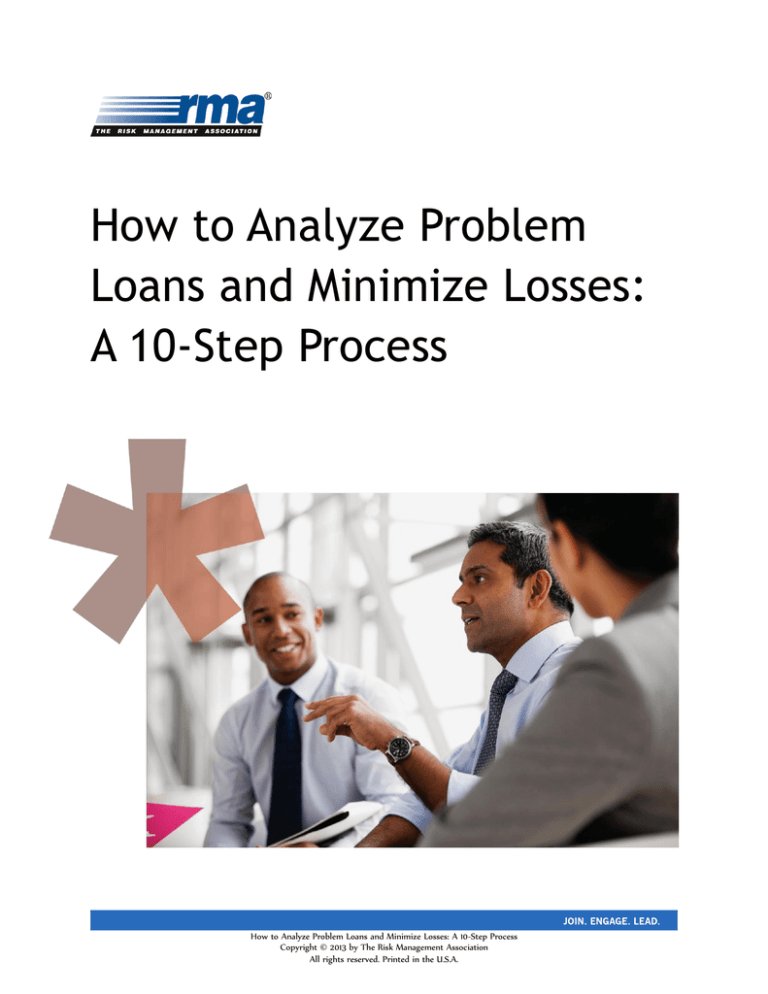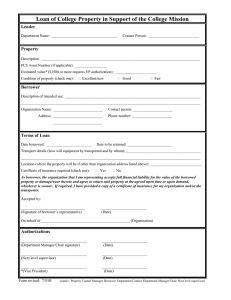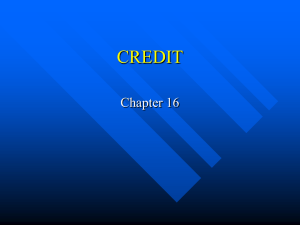
How to Analyze Problem
Loans and Minimize Losses:
A 10-Step Process
How to Analyze Problem Loans and Minimize Losses: A 10-Step Process
Copyright © 2013 by The Risk Management Association
All rights reserved. Printed in the U.S.A.
Contents
Step 1: Review the Documentation ........................................................................................................ 4
Step 2: Perform a New Lien Search ........................................................................................................ 4
Step 3: Collateral Valuation and Constraints ....................................................................................... 4
Step 4: Financial Analysis ............................................................................................................................ 6
Step 5: Identification of All Related Debt ............................................................................................. 6
Step 6: Evaluation of Management ........................................................................................................ 7
Step 7: Evaluation of Business Operations ........................................................................................... 7
Step 8: Evaluation of Environmental Issues ......................................................................................... 8
Step 9: Viability Assessment ...................................................................................................................... 8
Step 10: The Action Plan ............................................................................................................................. 8
How to Analyze Problem Loans and Minimize Losses: A 10-Step Process
Copyright © 2013 by The Risk Management Association
All rights reserved. Printed in the U.S.A.
Page | 2
Page | 3
How to Analyze Problem Loans and Minimize Losses: A 10-Step Process
Copyright © 2013 by The Risk Management Association
All rights reserved. Printed in the U.S.A.
To minimize losses on a problem loan, you must first analyze the loan by ensuring that all of the pertinent
information is taken into consideration. The benefits of using a systematic approach to your analysis include 1)
consistency, i.e., each individual in the decision-making process uses the same information, and 2) error
minimization, i.e., it reduces your chances of missing an important issue or fact.
The following process will help you gather and understand the facts, analyze the problem, and enable you to
make a recommendation to correct the problem. The process is not entirely sequential—some steps occur
simultaneously and often overlap.
Step 1: Review the Documentation
Operational or documentation risk is a critical area, which represents a major contribution to loan losses.
Although most banks use some form of standardized documentation, it is not uncommon to incur deficiencies
due to improper use of the forms, modifications to the forms, or improper completion of the forms. Over the
years nearly 30% of commercial loan losses can be attributed to documentation deficiencies.
It is appropriate for you to use a professional for the review of the legal documents. Legal counsel, who would be
representing the bank in the event of subsequent litigation, would be the best individual to complete this review.
The use of an attorney may be expensive, so you need to weigh this selection against the size and complexity of
the credit. If you do the review before the borrower falls into serious trouble, the borrower may be more
cooperative in making your desired document changes.
Step 2: Perform a New Lien Search
Perform a new lien search. Then determine lien priorities. Generally, the first to file is the first in right. However,
a few exceptions to this rule exist:
Purchase money security interests (PMSI). Note that there is a difference between inventory and
equipment claims. Inventory PMSI claims are effective for shipments after filing and notification.
Equipment PMSI claims are effective up to 20 days after delivery and without notification.
The 45-day Rule for judgment and tax claims provides these parities with a superior claim against new
assets generated 45 days after filing.
Bonding companies have the right of equitable subrogation on the assets of only the bonded job and are
not required to file financing statements.
Subscribing to a continuous records search on the borrower with a licensed and bonded search firm will keep you
informed (though it is not guaranteed); the cost is modest.
Step 3: Collateral Valuation and Constraints
Once you are satisfied that the documentation provides your bank with a solid first claim on the collateral,
determine what the true value of the collateral is.
How to Analyze Problem Loans and Minimize Losses: A 10-Step Process
Copyright © 2013 by The Risk Management Association
All rights reserved. Printed in the U.S.A.
Page | 4
There are three critical aspects of collateral valuation:
1. Current asset valuation adjustments.
In determining the loan value of accounts receivable, you should be aware of:
Aged invoices. Beyond a specified date (DOI).
Contra accounts. Buying from and selling to the same party provides an automatic offset and is
common in most businesses.
Bonded accounts. The assets of the bonded job are subject to the prior claim of the bonding
company and thus offer no value to the bank.
Unbilled receivables. These assets are questionable because the borrower’s customer is unaware of
Page | 5
the obligation because the customer has received no invoice.
Pre-billed receivables. The customer has billed before the work is done; yet it has already recorded
the sales and earnings.
Bill and hold receivables. Again the borrower’s customer is unaware of any obligation because the
invoice is retained by the borrower and not sent to the borrower’s customer.
Conditional receivables. These are payable only after conditions are met. These should be verified
with the obligor, not the borrower. Hereto, revenue and earnings are recorded before the asset is a
true receivable.
Consigned receivables. These are not technically receivables, but inventory held at different locations
for sale.
Outstandings over concentration limits.
Remember to obtain aging of accounts receivables by date of invoice, not due date.
Other items to watch are concentrations, percentage of completion (used in the construction industry),
retainages, partial shipments, the credit quality of the accounts, and rewrites and re-billings.
2. Collateral constraints.
Troubled accounts often move (on average once per year) to reduce costs. They are also under pressure to
protect (hide) assets.
• Lay legal claim to the collateral. This is where legal documentation comes into play. Without a blanket
lien on the assets, the bank’s documentation must clearly identify and distinguish its collateral from the
other assets.
• Take possession of the collateral. The repossession process must meet the legal requirements and may
require the help of law enforcement.
• Verify the condition of the collateral. The condition of the collateral will have a significant impact on
the value and salability of the security. If the collateral is perishable, then further constraints affect the
collectability from the disposal of those assets.
• Sell the asset for value. Your bank needs to sell the asset for value in a commercially reasonable way,
as defined by the law.
3. Appraisals.
How to Analyze Problem Loans and Minimize Losses: A 10-Step Process
Copyright © 2013 by The Risk Management Association
All rights reserved. Printed in the U.S.A.
At the first sign of trouble, you should reaffirm the value of equipment and real estate. You can best do this
by obtaining an updated appraisal ordered from a qualified appraiser (a member of the Appraisal Institute
[MAI]). There are a number of different values that can be obtained.
• Forced liquidation—what your bank can get.
• Orderly liquidation—what the borrower might get.
• Cost or book—what is on the balance sheet.
• Market—what a buyer would pay in good times.
• Enterprise value—what a going business might fetch.
• Value in use—what it means to the borrower.
• Replacement—what it will cost to replace.
Appraisals on equipment and inventory should contain the same level of detail and support typically provided
in a real estate appraisal.
Step 4: Financial Analysis
The value of a financial analysis is predicated upon how current the borrower’s and each of the guarantors’
financial statements are, as well as the quality of the accounting. Obtain current information, ideally within a
short time of the most recent period covered. If the statements are not audited, be sure the obligor signs them.
Focus your analysis on:
Cash flow (operating, investment, and financial) to measure soundness and ability to meet obligations.
Cash is king. You need to know the amount, the timing of funds flow, and its uses. In addition to
principal and interest, capital expenditures need to be factored into the company’s operation.
Assets and leverage to help you evaluate safety and the collateral situation. Be sure to include lease
obligations, which are often off balance sheet. Remember the rights of a lessor are often greater than the
rights of a creditor.
Short-term (maximum three months) budgets or forecasts to help you identify changes in safety and
soundness in the near term. The emphasis here is on short. The bank needs to get to first base before it
determines how it will score (collect).
A break-even analysis is often a useful tool to identify financial issues and possible corrective action.
Step 5: Identification of All Related Debt
In order to make an intelligent decision, you need to be aware of all of the borrower’s obligations. This step also
uncovers valuable assets (deposits, trusts, etc.) that may affect the final course of action.
The big picture of all related debt includes:
• Related entity debt. Parent, subsidiaries, affiliates, etc.
• Related guarantor debt. Mortgages, credit cards, auto loans, home equity credit, etc.
How to Analyze Problem Loans and Minimize Losses: A 10-Step Process
Copyright © 2013 by The Risk Management Association
All rights reserved. Printed in the U.S.A.
Page | 6
• Off-balance sheet obligations. Leases and other commitments. Most businesses lease assets (buildings,
furniture, computers, vehicles etc.).
• Contingent obligations of the debtor and/or guarantor. Guarantees, contracts, etc.
• Search both inside and outside of the bank.
Step 6: Evaluation of Management
Problem awareness. How engaged is management in the recognition of their problem(s) and have they
Page | 7
taken action (right or wrong, have they moved)?
Cooperativeness. No matter how resolvable the problem(s), unless you have the cooperation of the
management team, ultimately, nothing will get resolved.
Honesty. Without this “C” of credit (character), you need to exit the relationship as quickly as you can;
you will never have a relationship that you will want to preserve. It may require a loss; however,
remember, with a dishonest borrower, your first loss will likely be your least loss.
Capability. While you may have all the other factors needed of the borrower, the borrower must have the
ability to work out of the problem(s). You may need to introduce the concept of a consultant (hired
talent, usually expensive) who frequently takes a part of the ownership of the business in lieu of cash
payment, or who takes some form of interest in the business that might be repurchased on an agreed
upon price, etc.
Committed. Workouts extend over time and therefore require that not only the bank be committed, but
also the borrower and its management.
Open to suggestions. The borrower is willing to accept outside assistance.
Step 7: Evaluation of Business Operations
This step is less scientific than the previous steps, but just as critical. There is no better way to get behind the
numbers than to visit the borrower. At the customer’s place of business, sit down with key management to review
their operations. A tour of the facilities should be part of this visit. Find out how knowledgeable management is
about the activities you observe and how well they control these functions. Take time to review reports with
management, such as accounts receivable aging, job status reports, the inventory system, etc. Ask questions about
any item that catches your attention.
A value-added part of this process is to compare the company to RMA’s Annual Statement Studies data, and
share this information with your customer. Open communications is a two-way street.
This is also a good time to observe the quality and condition of the bank’s collateral. General observations you
should be making include:
Do operating assets seem neat and orderly or are they in dusty piles?
Does the business activity look busy and smooth?
Are incoming raw materials efficiently fabricated into finished goods?
How to Analyze Problem Loans and Minimize Losses: A 10-Step Process
Copyright © 2013 by The Risk Management Association
All rights reserved. Printed in the U.S.A.
Are products “made to order” or “made on speculation?”
Step 8: Evaluation of Environmental Issues
Evaluate the business’s environment. The term environmental is used here in its broadest sense.
Competition. Has a well-known competitor or a new, competitive technology entered the market? This is
the who, what, where, and market share breakdown.
Markets/territory. Can management control its business in these markets? What are the advantages, stage
Page | 8
of life cycle (growing, mature, or declining)?
Products/services. Does the customer have the right mix of product/service? Factor with the product’s life
cycle (growing, mature, or declining).
Distribution system. Does the borrower have good access to the market and the ability to provide justin-time service? What is its support for marketing and distribution?
Environmental impact. How does the business impact the environment? Is the borrower in compliance
with the Environmental Protection Agency (EPA) and state agencies’ regulations? Proceed with care when
dealing with high-risk businesses such as dry cleaners, gas stations, refineries, chemical facilities,
laboratories, etc.
Seasonal. Industries affected by the weather (skiing, swimming, amusement parks, etc.)
Step 9: Viability Assessment
Normally, the biggest challenge is to shift management away from trying to “grow out of the problem.” Growth,
in most instances, will increase the business’ problems—especially with the added strain on cash flow. The best
thing a company in trouble can do is return to the basics; the core which previously made the business attractive.
The first and most critical question is, “Does management accept the core consolidation concept, i.e., can
the borrower survive?” Another part of this same question is, “Can management adjust to this new,
aggregated way of doing business?”
What resources are necessary?
What resources are available and where will they come from?
How much is your bank willing to invest? On this point, do not rush to be the business’s first source of
money. Make the borrower look within first. What do they have (company or personal) to provide the
needed funds, how liquid is it?
Step 10: The Action Plan
Decide what you want to do! Always keep in mind that your primary duty is to protect the interests of
the bank. Look for a win/win opportunity. The customer returns to health and the bank gets repaid on
reasonable terms. Remember that lose/lose is where the customer fails and the bank takes a loss. This
How to Analyze Problem Loans and Minimize Losses: A 10-Step Process
Copyright © 2013 by The Risk Management Association
All rights reserved. Printed in the U.S.A.
latter choice is typically made when the borrower is dishonest. In that instance, the bank’s first loss is its
least loss!
Decide how to implement your plan. The best results come from plans that coincide with the borrower’s
business plan and are presented directly to the borrower in face-to-face meetings. Beware of lender
liability issues.
Develop a time line for the plan. The critical factor here is to keep it short (days, weeks, or months) and
to have a good means of monitoring compliance on a frequent and regular basis.
Obtain bank management buy-in, to the plan. This not only avoids second-guessing, but more
importantly adds seasoned advice and input into your plan.
Page | 9
How to Analyze Problem Loans and Minimize Losses: A 10-Step Process
Copyright © 2013 by The Risk Management Association
All rights reserved. Printed in the U.S.A.
About RMA
RMA University
The Risk Management Association (RMA) is a notfor-profit, member-driven professional association
serving the financial services industry. Its sole
purpose is to advance the use of sound risk
principles in the financial services industry. RMA
promotes an enterprise approach to risk
management that focuses on credit risk, market risk,
operational risk, securities lending, and regulatory
issues.
In today's rapidly changing financial services
industry, you need practical, day-to-day knowledge
that will help you excel in your profession. RMA
provides quality education to advance sound risk
principles in the financial services industry.
Traditional classroom training and online learning
resources are available as open enrollments or inbank training. Visit http://www.rmahq.org/eventstraining/rma-university to learn more.
Founded in 1914, RMA was originally called the
Robert Morris Associates, named after American
patriot Robert Morris, a signer of the Declaration of
Independence. Morris, the principal financier of the
Revolutionary War, helped establish our country’s
banking system.
eStatement Studies
Today, RMA has approximately 2,500 institutional
members. These include banks of all sizes as well as
nonbank financial institutions. RMA is proud of the
leadership role its member institutions take in the
financial services industry. Relationship managers,
credit officers, risk managers, and other financial
services professionals in these organizations with
responsibilities related to the risk management
function represent these institutions within RMA.
Known as RMA Associates, these 16,000 individuals
are located throughout North
America and financial centers in Europe,
Australia, and Asia.
No part of this publication may be reproduced, by
any technique or process whatsoever, without the
express written permission of the publisher.
Phone: 800-677-7621
Fax: 215-446-4101
Website: www.rmahq.org
RMA’s eStatement StudiesSM is the only source of
comparative data that comes directly from the
financial statements of small and medium-size
business customers of RMA’s member institutions.
Round-the-clock online access gives you the ease
and flexibility to use this wealth of information at
your convenience. Visit http://www.rmahq.org/toolspublications/tools/estatement-studies
to learn more.
Are you an RMA member?
An RMA membership provides many benefits.
In addition to a free subscription to The RMA
Journal® and discounts on RMA events,
products, services, and training, membership
also provides countless networking
opportunities and exposure to the industry's key
decision makers and managers. RMA’s local and
national events keep you up to date on industry
trends and issues while allowing you to meet
new people and swap successes with peers. Visit
http://www.rmahq.org/about-rma/memberbenefits to learn more about membership.
How to Analyze Problem Loans and Minimize Losses: A 10-Step Process
Copyright © 2013 by The Risk Management Association
All rights reserved. Printed in the U.S.A.



